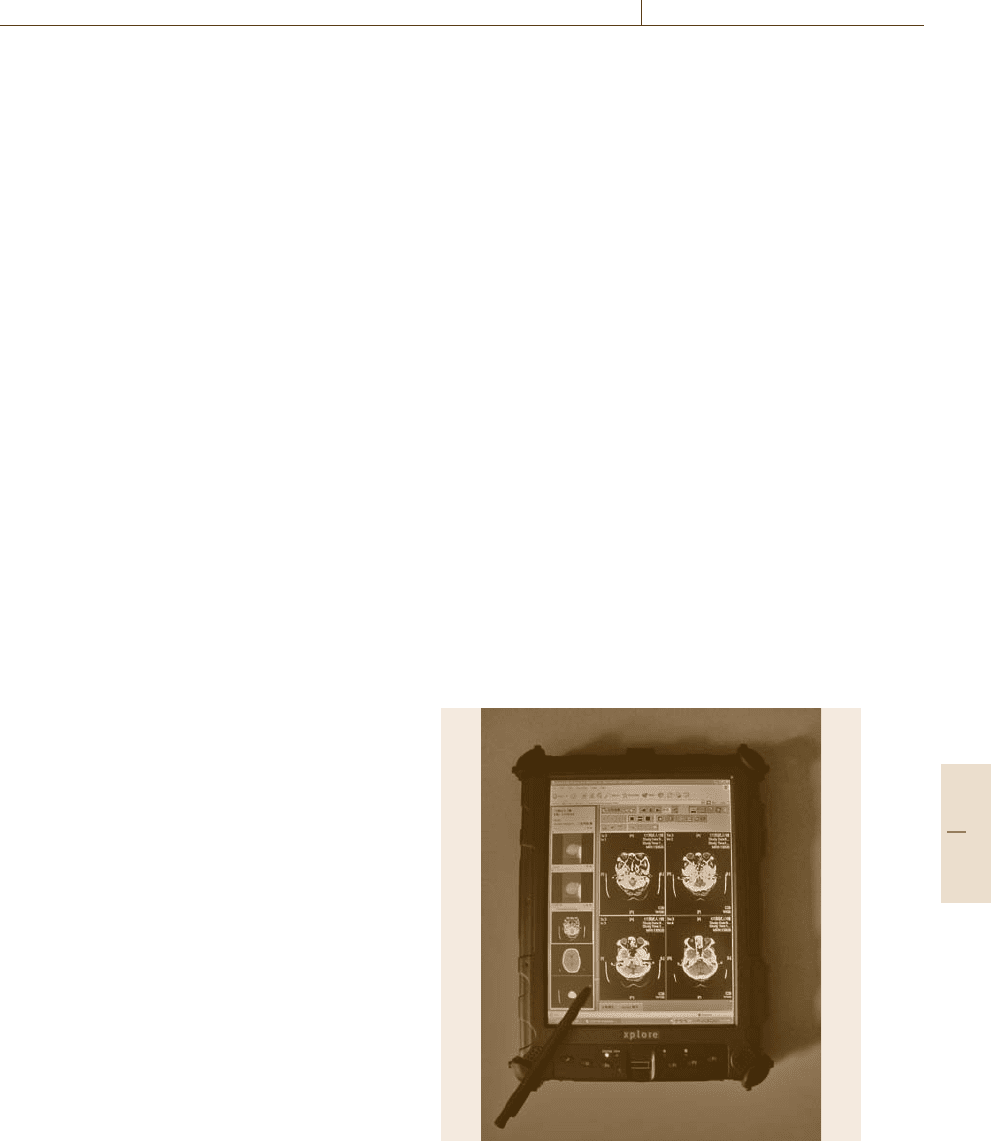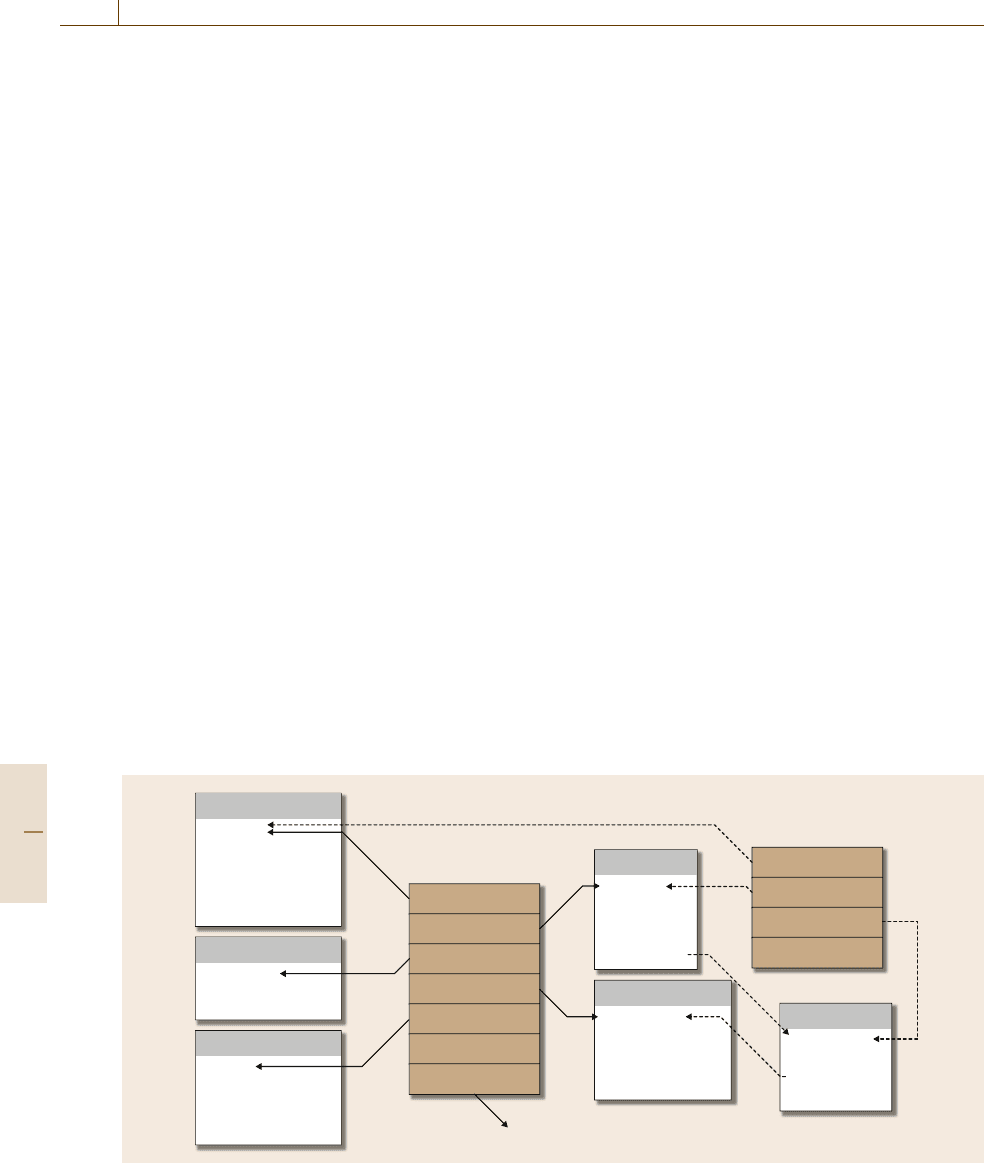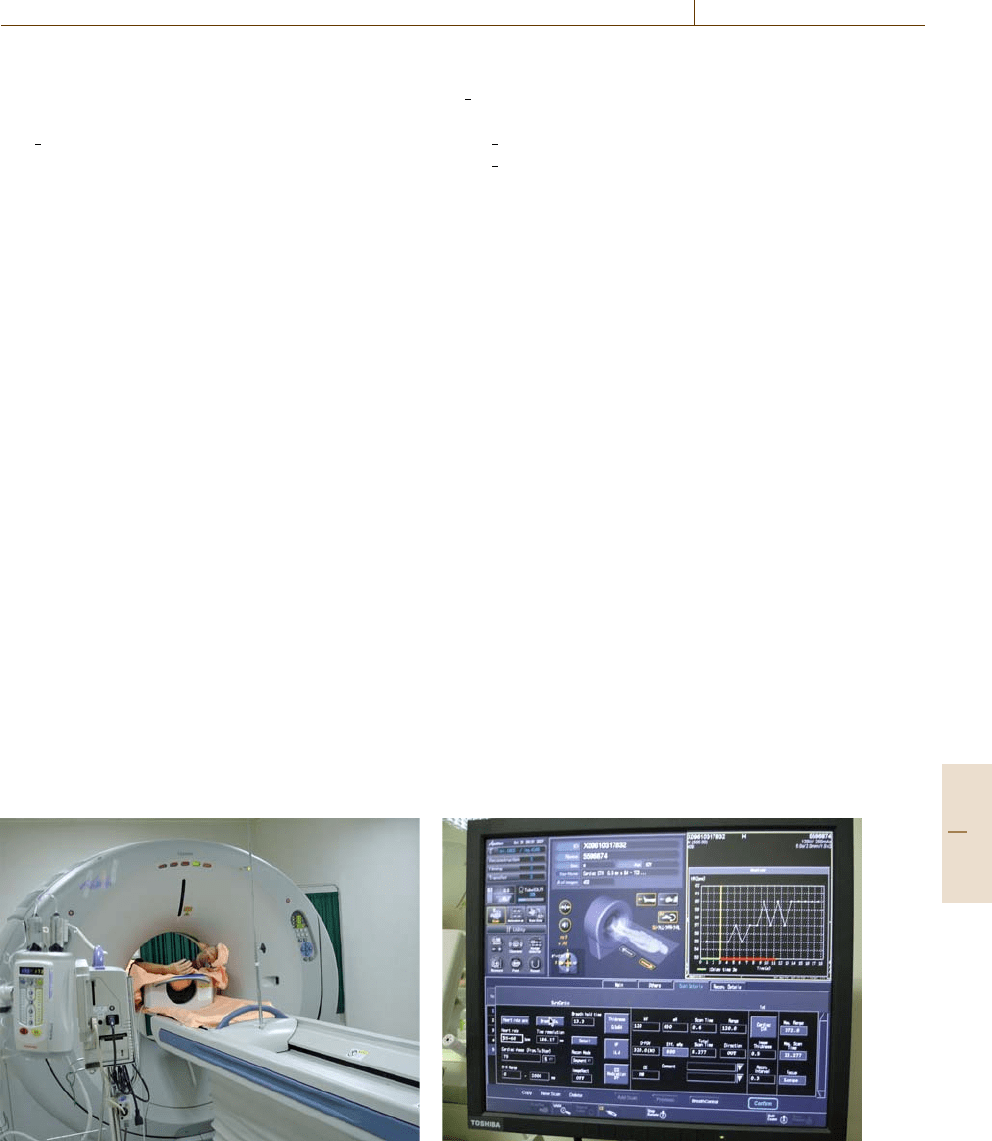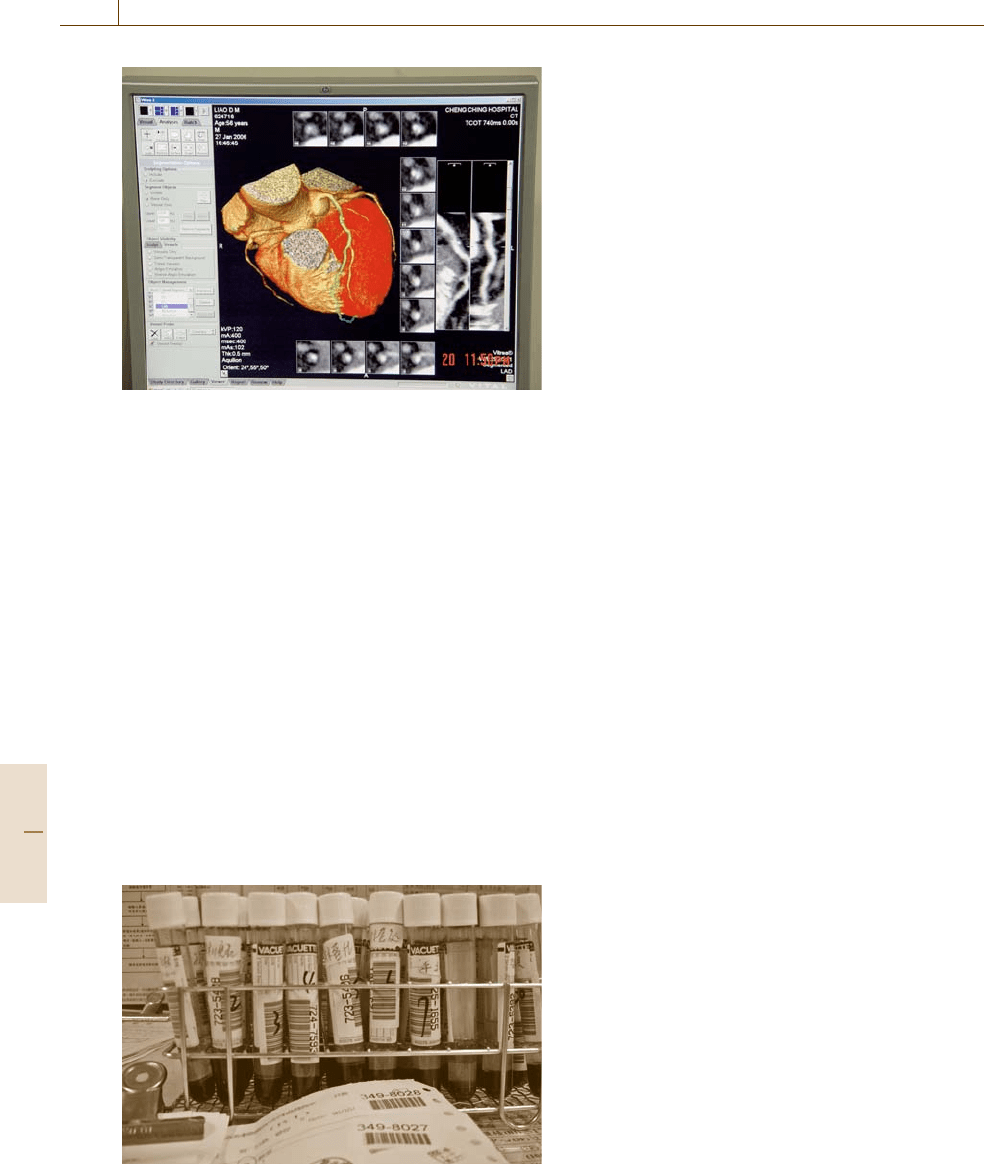Nof S.Y. Springer Handbook of Automation
Подождите немного. Документ загружается.


Medical Informatics 80.3 Communication and Integration 1425
and (2) results of observations. Figure 80.1 shows two
computer screens for a medical doctor when checking
patients. The left screen is used to display the results
of observation (x-ray), whereas the right screen is an
order entry system to show anamnesis and other re-
sults of tests. Diagnosis may take a long time, since
the patients maydescribe their complaintsincompletely,
which may lead the doctor to order the wrong tests
or treatments. Then, an iterative observation-diagnosis-
therapy occurs. For patients who have chronic diseases,
iterations may repeat over and over for a long time pe-
riod. However, sometimes the iterations occur because
of mistakes/errors resulting from doctors, pharmacists,
nurses, or inspecting staffs and/or facilities.
Therapy cannot be done without the orders from
doctors. It may be done through medication, surgery, re-
habilitation, or diet control. Technologies of therapy are
constantly evolving. Due to its advancement, life quality
of patients is improving.
Observation, diagnosis, and therapy form a cycle
(Fig.80.2). The cycle stops only when the patient is
cured or decides to quit the cycle.
80.3 Communication and Integration
Medical services in modern hospitals are fulfilled by
a group of specialists: physicians, nurses, pharmacists,
biologists, and administrative and laboratory staffs.
Moreover, medical services are fulfilled by advanced
facilities, and information and computer technologies.
Patients are cared for by an integrated system consisting
of the above-mentioned specialists and expensive facil-
ities. The integrated system can function efficiently and
effectively only when theindividualpersons or facilities
can be integrated through a communication system.
Communication as a key component for integra-
tion requires two elements: channels and interfaces.
Channels mean how the persons or facilities are
connected. Most medical facilities can offer commu-
nication with a local area network (LAN) by applying
TCP/IP standard protocol. Therefore, specialistscan up-
load/download or operate the facilities within the LAN.
Associated clinics or outside laboratories may be autho-
rized to use the Internet as a channel to obtain data from
the facilities of hospitals. For short distance transmis-
sions, WiFi provides a wireless alternative of communi-
cation. It is useful for a doctor to display patient records
or to give a medical order when checking with a patient
in a ward with a mobile/wireless handheld device, per-
sonal digital assistance (PDA) for example. Figure 80.3
shows a portable computerized order entry device. It is
a WiFi and web ready system. By its powerful com-
puting, communication, and graphic capabilities, physi-
cians can display the test results of patients and give
treatment or medication orders when they are checking
with patients anywhere in the WiFi coverage zone.
Interface means that facilities speak the same lan-
guage. Usually an interface is fulfilled by standards.
For administrative data exchange in healthcare, Elec-
tronic Data Interchange for Administration, Commerce
and Transport (EDIFACT) is used in Europe [80.3],
whereas Health Level 7 (HL7) is used in the United
States [80.4]. With the standards, participants (such as
clinics, laboratories, drug stores, and insurance com-
panies) can encode and decode messages by the same
format, which speeds up communication and enables
integration of processes occurring between units of
a hospital or between hospitals. For medical images
such as x-ray, CT, and magnetic resonance imag-
ing (MRI), digital imaging and communication in
medicine (DICOM) is a standard for image communi-
cation [80.5]. DICOM also plays a role of standardizing
the image inputs/outputs of medical facilities developed
by various vendors.
Fig. 80.3 Portable medical order-entry device (photo cour-
tesy of DVNET Technology Co., www.dvnet.biz)
Part H 80.3

1426 Part H Automation in Medical and Healthcare Systems
80.4 Database and Data Warehouse
Most healthcare organizations host large databases to
maintain the demographical records, complaints and
diagnostic records, laboratory tests and inspections, or-
ders of therapy, and insurance and payment records that
are associated with each patient. The massive amount
of healthcare information requires a database that has
a storage capacity of multiple terabytes (TB). There
are several reasons why a large storage capacity is re-
quired. First, voice, image, and video types of test and
inspection data are gradually playing an important role
in healthcare. They usually take up large data storage
space. Besides, health authorities of government and
insurance companies usually demand hospitals to main-
tain the records for a certain period, which also results
in the need for large storage space. Although the cost
per byte of data storage is decreasing yearly, larger and
more urgent demands on storage space still increase the
total cost of database system year by year in modern
healthcare organizations.
Though today’s object-oriented database (OODB)
seems to be a suitable solution to accommodate var-
ious data formats, which include text, audio, video,
animation, and image, and can manage linked rela-
tionships easily, its low performance in transactions
hinders the applications of OODB in healthcare organi-
zations. Relational database (RDB) presenting database
in flat tables is a typical database for healthcare orga-
nizations. The advantages of RDB include supporting
the standard structural query language (SQL), scalable
Time
time_key
day
day_of_the_week
month
quarter
year
Drug
drug_key
item_name
brand
type
supplier_key
Address
address_key
street
city
province_or_street
country
Supplier
supplier_key
supplier_name
adress_key
supplier_type
time_key
drug_key
doctor_key
address_key
ID_key
dollars_sold
order_key
Patient order table
time_key
drug_key
supplier_key
dollars_cost
Purchase fact table
Doctor
doctor_key
doctor_name
department
Demography
ID_key
gender
date_of_birth
phone
marriage
Fig. 80.4 A fact constellation scheme of a data warehouse for patient records
performance, and easy maintenance. Besides, because
of the abundance of human resource supply in the
field of RDB development, operation, and mainte-
nance, RDB is commonly used in healthcare database
applications.
However, maintaining large and complicated med-
ical databases may become a financial burden for
healthcare organizations, unless the value of medical
databases is created. To utilize the value of a large
medical database relies on the development of a data
warehouse. Data warehouse is a collection of associated
databases. Databases in a data warehouse are subject-
oriented and nonvolatile. Subject-oriented means that
the database storage focuses on a special issue, such
as patient treatments or medical records for certain
cancers. Nonvolatile means that the data in a data ware-
house should be extracted from the databases and are
not changed by online transactions. Besides, the online
analytical process (OLAP) is an important function to
retrieve useful information from a data warehouse. Ba-
sic command functions of OLAP include rolling up,
drilling down, slicing, dicing, etc. [80.6]. However, to
successfully apply OLAP depends on how well the data
warehouse is defined.
A data warehouse is defined by specifying the link
relationships among flat tables. Figure 80.4 shows an
example to demonstrate link relationships among tables
in a data warehouse with fact constellation. It shows
that there are many keys for patient order tables. Each
Part H 80.4

Medical Informatics 80.5 Medical Support Systems 1427
key is linked to other tables. By the links, a user can
give an OLAP command. For example, showing the
total patient orders for the last month (dicing through
time
key), then showing the patients according to the
departments they went to visit (drilling down). The
drilling down command is possible because the doc-
tor
key links both the patient order table and the doctor
table. Through the link, each patient order can find the
doctor
key. By querying in the doctor table with the
doctor
key, the department is found.
80.5 Medical Support Systems
Today’s healthcare activities are supported by informa-
tion systems and digitized facilities. For this reason,
care of patients has become more efficient, timely, and
accurate. Medical support systems, besides the hospital
information system (HIS) that manages both informa-
tion of patient care and administration, includes at least
four subsystems:
1. Solitary imaging information system
2. Laboratory information system
3. Functions of hospital pharmacy
4. Nursing information systems.
In the following sections, the four subsystems are intro-
duced.
80.5.1 Solitary Imaging Information
Systems
Most modern hospitals own expensive solitary imag-
ing systems, such as x-ray, CT, MRI, digital subtraction
angiography (DSA), gamma cameras, and positron
emission tomography (PET). CT, MRI,andDSA are
mostly found in the radiology department, whereas
gamma cameras and PETs are found in the nuclear
Fig. 80.5 A multislice CT volume scan system (photo
courtesy of Cheng Ching General Hospital)
medicine department, since with these radioactive ma-
terial, which is under government management, is
injected into the veins of a patient in the inspection
process. Figure 80.5 shows a multislice CT volume
scan system. CT is a typical noninvasive examination
in today’s healthcare services. An examination on a CT
involves various kinds of monitor and control of the
CT system. Figure 80.6 shows multiple monitoring and
control functions onboth patientsand the CT system. To
integratethe solitary imaging systems with HIS requires
a standard for exchanging image data. As mentioned
in Sect.80.3, DICOM is a standard for image data ex-
change. With it, associated healthcare practitioners can
view the images across different systems, whether they
be inside or outside the hospital. An example of a CT
image is shown in Fig. 80.7. Some radiologists even
check images of patients in various hospitals through
the Internet.
80.5.2 Laboratory Information Systems
Besides solitary imaging systems, many tests may be
performed in a laboratory or even a clinical room
by portable devices. Equipment in a laboratory may
Fig. 80.6 Multiple monitoring and control functions on
both patients and CT system
Part H 80.5

1428 Part H Automation in Medical and Healthcare Systems
Fig. 80.7 Example of a CT image (photo courtesy of
Cheng Ching General Hospital)
include an electrocardiogram (ECG), ultrasound, or
spirography. Biosignals produced by the equipment are
digitalized and conformed to DICOM, so that they can
be integrated into a HIS. Additionally, those biosignals
are collected synchronously with patients, which means
that the patients must stand by when the biosignals are
recording.
Besides the previous synchronous examination,
some examinations are asynchronous. In other words,
the examinations only need specimens from patients
and do not need patients to wait while the equip-
ment is examining. Hospitals host laboratories to give
asynchronous examinations of specimens from patients,
such as blood and urine. Electron microscopes and
centrifuges are typical examples of equipment for lab-
oratories. To perform pathological examinations, the
systematized nomenclature of medicine (SNOMED) is
a code system that indicates various aspects of a dis-
Fig. 80.8 Examples of specimens (each with a barcode)
ease [80.7]. It is a checkbook for diseases based on
specimens from patients.
There are two basic activities that a hospital labora-
tory has to do for either synchronous or asynchronous
examinations. The first activity is about getting sam-
ples or biosignals from patients. In the first activity,
there must be a system for registering the patient ID
and the examinations that were ordered by a doctor.
For an asynchronous examination, usually a specimen
from a patient is labeled by a barcode that shows the
identical patient ID to avoid mismatching with other
patients’ specimens (Fig.80.8). As long as the speci-
mens’ barcodes are recorded into HIS, laboratory staff
schedule a time for the examination. The second activ-
ity is to deliver the examination report to HIS. For both
synchronous and asynchronous examinations, the ex-
amination reports are presented in text, audio, or video
and have to be stored in the database of HIS so further
diagnoses or therapies can be ordered by a doctor.
Usually a laboratory information system involves
various kinds of workflows. Those workflows instruct
the administrative and laboratory staffs to efficiently
deliver services to patients.
80.5.3 Hospital Pharmacy Information
System
The hospital pharmacy is an important service unit that
supports care of patients. Usuallythe organization of the
hospital pharmacy is divided into two parts, one for in-
patients and the other for outpatients. The information
system of the hospital pharmacy includes an inventory
planning and control system that monitors the inventory
levels of drugs and purchases drugs whenever neces-
sary to maintain high service quality and low inventory
cost of the pharmacy. Besides, the pharmacy informa-
tion system for outpatients should maintain and manage
the dispensing information given by clinicians. How-
ever, it should allow immediate changes if some other
concerns such as drug interactions occur. For inpatients,
the information system should monitor the drug usage
of patients, so further therapeutic and billing procedures
can proceed based upon this information.
A more advanced pharmacy information system has
an embedded knowledge base system todetect the prob-
lems of drug interactions and mistaken orders issued
by doctors. The pharmacy information system is usu-
ally a subsystem of an HIS in modern hospitals. Some
hospitals may not maintain a hospital pharmacy for
outpatients. However, the dispensing information is de-
livered through the Internet to drug stores designated
Part H 80.5

Medical Informatics 80.6 Medical Knowledge and Decision Support System 1429
by outpatients. In this case, an HL7 or EDIFACT proto-
col will be needed to provide a standard communication
between hospitals and drug stores [80.8]. The current
version of HL7 relies on an XML based message syn-
tax. Through XML syntax, a doctor can embed required
drug dispensing information, e.g., patient, drug product,
dosage, etc., into a message, which is then delivered to
the designated drug store.
80.5.4 Nursing Information Systems
According to Murnane et al. [80.9], three key nurs-
ing information modules are required to successfully
deliver nursing care to patients:
1. Care plan
2. Workload allocation
3. Resource scheduling/monitoring.
HIS provides general patient information, and treat-
ment and drug orders from physicians. However, the
information is not enough for nursing care as soon as
a patient enters into a ward or intensive care unit. To de-
tail the nursing care and utilize the nursing human and
equipment resources relies on an integrated nursing in-
formation system that can seamlessly interact with HIS.
A nursing information system can indicate the relation-
ships among ward, patients, nurse, working shifts, and
basic nursing requirements of the patient.
80.6 Medical Knowledge and Decision Support System
MYCIN is an early yet typical decision support system
that adopts expert systems, or now called knowledge
base systems, in medicine [80.10]. It was designed to
diagnose infectious blood diseases, and then to give
recommendation on the use of antibiotics. There are
only few medical cases like MYCIN in today’s medical
applications. The reason is that to make a knowledge
base useful relies on complete and correct knowl-
edge of medicine. Partial or incomplete knowledge
may lead to an incorrect decision, which may guide
a doctor to a wrong decision on patient care. Besides,
because of the advancing medical knowledge and tech-
nology, to keep a medical knowledge base system up to
date would be a huge burden for medical doctors and
computer specialists in debugging the decision rules.
However, medical knowledge and management has im-
proved by information technologies in two aspects:
evidence-based medicine and data mining. These two
aspects are addressed especially in the following two
sections.
80.6.1 Evidence-Based Medicine
Evidence-based medicine (EBM) is defined as [80.11]:
The conscientious, explicit and judicious use of cur-
rent best evidence in making decisions about the
care of individual patients, based on an integra-
tion of individual clinical expertise with the best
available external clinical evidence from systematic
research and patient’s unique values and circum-
stances.
Fundamentals of EBM include three major steps:
1. Knowledge findings based on medical evidence
databases
2. Applications of the findings to patients
3. Evaluating the applications and modifying the
knowledge findings if necessary.
Knowledge findings usually involve many database
and statistical operations on the medical data. Most
healthcare journals play a role in publicizing medical
treatments and knowledge findings for medical doctors
and scientists. Unlike traditional healthcare research
that usually involves limited number of cases, by the
introduction of digital databases and government sup-
port for accumulating patient and treatment records, the
number of cases involved in the study based on the
government support dataset (e.g., the Surveillance, Epi-
demiology, and End Results (SEER) program [80.12]
and NHIRD of Taiwan [80.13]) is very large. The num-
ber of cases can be as large as one million or more.
Thus, the reliability of the research results increases,
which implies that the reliability of such an EBM is also
higher.
80.6.2 Data Mining Techniques
Large-scale medical databases not only increase the re-
liability of EBM research results, they lead to other
potential uses of the data. Traditional EBM studies
usually applied statistical tools only. By data mining
techniques [80.6], medical researchers are able to find
other evidence that usually involve more variables and
Part H 80.6

1430 Part H Automation in Medical and Healthcare Systems
are not based ontesting the hypotheses made in advance
by people. Notwithstanding, data mining techniques
can be applied to investigate medical improvement and
patient relationship management in general hospital
management based on the records of patient visits.
Major data mining tools that may help healthcare
administration or healthcare services include:
1. Classification tools, e.g., decision trees and neural
networks
2. Clustering techniques, e.g., K-Means and hierarchi-
cal clustering
3. Association rules, e.g., apropri algorithm and rough
sets theory.
Classification is a tool to identify the relationships
between certain conditional (independent) variables
and a decision (dependent) variable. The relationships
are mostly specified to a certain range of conditional
variables (e.g., age between 20 and 25 or systolic hyper-
tension above140mmHg), and certainrange ofdecision
variables (e.g., annual cost of medical care between
$ 10000 and $ 15000). Because tools of decision trees,
such as ID3 and CHAID, provide clear IF-THEN rules
for presenting the relationships between variables, they
are more acceptable, in comparison with neural net-
works that define variable relationships as weights on
connections of neurons.
Clustering is a tool to separate a data set into
multiple subsets. A predefined distance that measures
similarity between two cases and methods for finding
clusters (subsets of data) are the two key elements in
clustering. Clusteringdoes not require a dependent vari-
able. Usually it is applied to handle data with a massive
number of variables. Clustering methods (algorithms)
iteratively check the distance between cases to find
clusters. Basically, the distance between two cases that
belong to the same cluster should be shorter than the
distance between two cases that belong to two different
clusters. The results of clusters are usually difficult to
interpret and apply, since distance is an unusual con-
cept in medicine, and the cases of each cluster may
include a large number of variables. Even so, cluster-
ing has been applied as a technique for analyzing gene
expression data in the biological field, e.g., [80.14], and
problems of clinical and medical care, e.g., [80.15]. For
example, Jannin and Morandi successfully apply deci-
sion tree and clusteringtechniques to predict parts of the
surgical procedure forbrain-tumor patients based on the
pathology-related characteristics of the patient [80.16].
Tools of association rules intend to find causal-
ity between variables. For example, patients who have
diabetes are also hypertensive (15%, 90%). The 15%
represents support for such a rule, whereas the 90% rep-
resents confidence. Support defines the proportion of
the number of patients who have both diabetes and hy-
pertension over the totalnumber of patients.Confidence
defines the proportion of the number of patients who
have both diabetes and hypertension over the number
of patients who have diabetes. An advantage of associ-
ation rules is that they can identify a causality that has
less support but high confidence. To search for a plau-
sible curable treatment or medication for rare disorder
patients is a typical problem that can apply techniques
of association rules, for two reasons. First, rare disorder
patients mean that the support is small. Second, if the
majority of the patients are cured by a common treat-
ment or medication, its confidence is high. Traditional
statistical tools that mostly do not allow a large number
of variables in the analysis and count on a large number
of samples are not able to handle such a problem.
Though data mining provides an opportunity for
finding medical evidence that may not be found by tra-
ditional statistical tools, few applications are performed
in the healthcare fields. Some researchers ascribe the
reasons to a large number of false alarms created by
data mining. Actually, the credibility of mining results
can be proved by cross-validation or some other re-
lated tools [80.17]. From the author’s perspective, there
are two major obstacles for data mining applications in
healthcare. First, healthcare practitioners may not be so
familiar with data warehouse and data mining. Second,
many legacy medical data tables are not normalized. It
is believed that both obstacles will be overcome in the
near future, because many multidisciplinary research
opportunities have been created for both healthcare and
computer science professionals.
80.7 Developing a Healthcare Information System
To develop a good healthcare information system re-
lies on at least three elements: the right people, the
right project management, and the right strategic plan.
Right people means that the healthcare information sys-
tem should cover the operation needs of major system
users (e.g., administrators, physicians, nurses, staff, pa-
Part H 80.7

Medical Informatics 80.8 Emerging Issues 1431
tients, etc.) Questions like how many people and what
kind of people should be included in the information
system depend on the budget and strategic plans of the
healthcare organization. The development of a health-
care information system is a complicated project. It
usually includes stages of requirement analysis, system
design or introduction, system implementation, system
tests, user training, and system validation. The range of
the project duration depends on the type of informa-
tion and may be one month to one year. Besides, the
people involved in each stage vary. Therefore, a well
organized project management is required to ensure
that the project can be successfully implemented and
applied in accordance with the planned schedule and
budgets.
The strategic plan for the healthcare information
system has to be set right so it can match the orga-
nization’s goals and external and internal environment
analysis. Because today’s HIS plays an important role
in patient care and costs much in investment, its success
depends on how well it meets the healthcare organiza-
tion’s goal. The steps of the development of a strategic
plan for a healthcare information system can be summa-
rized as follows:
1. Perform SWOT (strengths, weaknesses, opportuni-
ties, and threats) analysis for the organization.
2. Identify specifically how information systems can
strengthen the organization’s capabilities to catch
external opportunity.
3. Identify specifically how an information sys-
tem can avoid threats from internal and external
environments.
4. Identify healthcare information goals of the
organization.
5. Evaluatethe gap betweenthe healthcareinformation
goals and current information system.
6. Identify long-term information system objective
such that the gap can be filled.
7. Identify resource requirements to fulfill the
objective.
8. Make a budget plan for the resource requirements.
80.8 Emerging Issues
The advent of modern medical information technolo-
gies has largely improved patient care and the quality
of care. More specifically, a healthcare organization al-
most cannotfunction without the support of information
systems. However, there are still many research issues
waiting investigation. Some of them are addressed in
the following sections.
80.8.1 Quality of Care
How to utilize information technologies to improve the
quality of cares is always an issue. Each time a new
technology is introduced, the possibility for improve-
ment of care quality evolves. By means of today’s
radio frequency identification (RFID) technology, er-
rors in drug dispensing and operation rooms have been
reduced because an RFID reader system provides an
active alarm when a person, an article, a paper order,
a medicine, or a specimen embedded with an RFID
tag is not in the right place, right position, and right
time that he/she/it is supposed to be. Some case stud-
ies even suggested using RFID to monitor the walking
routes through wards of medical doctors and nurses,
so an alert system may be built to control nosoco-
mial infections. However, side effects of introducing
RFID system are inevitable, just like the side effects
of introducing barcode systems into the healthcare ser-
vices [80.18].
80.8.2 Security
Today’s healthcare organizations carry a lot of infor-
mation about patients. Securing the digital data today
is as important as securing the paper patient records
in the past. Hackers and computer viruses are the two
major sources that may jeopardize the safety of patient
records. It becomes financial and technical burdens for
healthcare organizations to secure large patient-record
databases. Some hospitals outsource healthcare infor-
mation systems to IT companies, so they can ease the
technology burden. However, ethical and legal issues
may arise if patient records are lost or stolen from those
outsourcing IT companies, for any reason.
80.8.3 Public-Use Databases
for Medical Research
To attract researchers to get involved in medical
studies, many governments are systemically building
public-use database for medical research. SEER is
Part H 80.8

1432 Part H Automation in Medical and Healthcare Systems
a typical database that accumulates cancer patients’
records (including demographical, histological, and
pathological information). The Taiwan government also
allows researchers to retrieve patient records (including
demographical information, insurance claims, drug dis-
pensing, and hospital information) for medical studies.
Such public-use databases give great opportunities for
researchers to investigate prevalence, survival analysis,
and other medical comparative studies. Since such stud-
ies are performed based on a large number of samples,
they can avoid errors resulting from a limited number of
samples ordata sources.Additionally, more data mining
technologies are applied to the databases to handle their
multiple dimension data tables.
References
80.1 N.B. Sarter, D.D. Woods, C.E. Billings: Automation
surprises. In: Handbook of Human Factors and Er-
gonomics, 2nd edn., ed. by G. Salvendy (Wiley,
New York 1997)
80.2 J.H.V. Bemmel, M.A. Musen, J.C. Helder: Handbook
of Medical Informatics (Houten, Springer 1997)
80.3 UNECE: United Nations Directories for Electronic
Data Interchange for Administration, Commerce
and Transport (2007)
http://www.unece.org/trade/untdid/welcome.htm
80.4 I. Health Level Seven: HL7 Standards (2007)
http://www.hl7.org
80.5 N.E.M. Association: The DICOM Standard (2007)
http://dicom.nema.org/
80.6 J. Han, M. Kamber: Data Mining: Concepts and
Techniques (Morgan Kaufmann, San Francisco 2001)
80.7 I.H.T.S.D. Organisation: Technical Documents (2007)
http://www.ihtsdo.org/
80.8 B.W. Chaffee, J. Bonasso: Strategies for pharmacy
integration and pharmacy information system in-
terfaces, Part 2: Scope of work and technical
aspects of interfaces, Am. J. Health Syst. Pharm.
61, 506–514 (2004)
80.9 R. Murnane, S. Brown, F. Kerr, M. Meehan, A.
McDonagh, E. Molony, Y. Mulligan: Nursing Work-
load Activity Analysis: A Critical Component of
the Mater Misericordiae University Hospital’s In-
tegrated Nursing Information System (INIS) (2006)
http://www.hisi.ie/html/news.htm
80.10 B.G. Buchanan, E.H. Shortliffe: Rule-Based Expert
Systems: The MYCIN Experiments of the Stanford
Heuristic Programming Project (Addison-Wesley,
Reading 1984)
80.11 S.E. Straus, W.S. Richardson, P. Glasziou,
R.B. Haynes: Evidence-Based Medicine: How to
Practice and Teach EBM, 3rd edn. (Churchill Liv-
ingstone, New York 2005)
80.12 SEER: The Surveillance, Epidemiology, and End Re-
sults (SEER) Program (2007) http://seer.cancer.gov/
80.13 NHIRD: National Health Insurance Research
Database (2003)
http://www.nhri.org.tw/nhird/index.php
80.14 S.A. Ness: Microarray analysis: basic strategies for
successful experiments, Mol. Biotechnol. 36,205–
219 (2007)
80.15 M.W. Isken, B. Rajagopalan: Data mining to
support simulation modeling of patient flow in
hospitals, J. Med. Syst. 26, 179–197 (2002)
80.16 P. Jannin, X. Morandi: Surgical models for
computer-assisted neurosurgery, Neuroimage 37,
783–791 (2007)
80.17 I.H. Witten, E. Frank: Data Mining: Practical Ma-
chine Learning Tools and Techniques, 2nd edn.
(Morgan Kaufmann, Amsterdam 2005)
80.18 E.S. Patterson, R.I. Cook, M.L. Render: Improv-
ing patient safety by identifying side effects from
introducing bar coding in medication administra-
tion, J. Am. Med. Inform. Assoc. 9, 540–53 (2002)
Part H 80

1433
Nanoelectroni
81. Nanoelectronic-Based Detection
for Biology and Medicine
Samir M. Iqbal, Rashid Bashir
This chapter is a review of the work in nanoelec-
tronic detection of biological molecules and its
applications in biology and medicine. About half
of the chapter focuses on the methods employed
to immobilize deoxyribonucleic acid (DNA)onsolid
substrates with particular focus on the electronic
detection and characterization of DNA. Charge-
transfer properties and theories are explained, as
such electronic and electrical sensing of molecular-
level interactions are very important in medical
applications for rapid and cheap diagnosis.
A special tool called nanopore, which has
been used extensively to characterize DNA,is
then reviewed. A special distinction is made
between the characteristics, capabilities, and
impacts of the biological and the solid-state
nanopores. Nanopores, when used in the ion
current measurement setup, are used to measure
the behavior of DNA as it traverses the nanopore.
When the DNA traverses the pore, the blockage of
the ion current is observed as a pulse. The statistical
analysis of the pulses yields trends that are used
to sort the DNA based on various properties. The
nanopores are strong prototypes for biosensors,
and have become a major experimental tool for
investigating biophysical properties of double and
single strands of DNA.TheDNA sequence can
81.1 Historical Background ...........................1433
81.2 Interfacing Biological Molecules.............1434
81.2.1 Guidelines for Preparing Silicon
Chips for Biofunctionalization........1436
81.2.2 Verification of Surface Densities
of Functional Layers .....................1437
81.3 Electrical Characterization
of DNA Molecules on Surfaces.................1438
81.3.1 Indirect Measurements
of Charge Transfer Through DNA .....1438
81.3.2 Direct Measurement
of DNA Conduction
and DNA Conductivity Models.........1438
81.4 Nanopore Sensors for Characterization
of Single DNA Molecules ........................1441
81.4.1 Biological Nanopores ....................1441
81.4.2 Solid-State Nanopore ...................1443
81.4.3 The Promise
of Low-Cost DNA Sequencing .........1446
81.5 Conclusions and Outlook .......................1447
References ..................................................1447
potentially be determined by measuring how the
forces on the DNA molecules, and the ion currents
through the nanopore, change as the molecules
pass through the nanopore.
81.1 Historical Background
Nanotechnology, in the last decade or so, has brought
together scientists and engineers from a diverse array
of fields to collaborate and share their distinct sets
of expertise and tools. The confluence of divergent
technologies has provided better handles on nanoscale
processes and species. Characterization and control at
these fundamental limits have shown immense poten-
tial to improve existing technologies and provide better
tools for understanding at the most basic levels of na-
ture. This has opened horizons wide open for many
diverse areas of research. The major impact it has
had, and will continue to have, is in medical applica-
tions. Biologists have known for decades that cells and
biomolecules are selectively managed, regulated, and
controlled, but the tools to organize and direct these in-
teractions are only now emerging, tools to handle and
Part H 81

1434 Part H Automation in Medical and Healthcare Systems
integrate synthetic structures in diagnostics and thera-
peutics. The nascent tools of nanoscience are helping
unravel the physics of biological processes in unprece-
dented detail. The detection and sensing of biological
entities has enormous promise, and challenges of cor-
respondence size. The challenges are manyfold: the
interface of the wet salty biological molecules to dry
cold solid devices, packaging of the devices so that only
the sensing partis exposed to theanalytes, faithful trans-
lation of the biophysical and biochemical interactions
into electricalor optical signals, selectivity of the device
against the analyte of interestin thepool ofthousands of
entities of no interest, identification of the useful signal
amongst unwanted noise, sensitivity of the measure-
ment systemall the way down tothe fundamentallimits,
and repeatability of measurements. For any system to
interrogate the few copies of the analyte of interest re-
producibly and reliably, the interface also plays a key
role. These challenges are the major impediments to the
integration of nanotechnology in biologicaland medical
applications.
A few industries that use a combination of en-
gineering, physics, chemistry, and biology in very
nontraditional approaches to develop devices for med-
ical applications have very recently emerged. Some
examples are on-chip DNA hybridization and opti-
cal detection, DNA detection at the nanoscale for
diagnostics in medical, military, and food safety ap-
plications, etc. DNA carries the genetic information
for living organisms and has a special, important
place in many areas such as genetic engineering, drug
discovery, and gene therapy. The methods used for
immobilizing DNA on solid substrates and the elec-
trical sensing schemes will be detailed in ensuing
sections in this chapter. As we go along, we will
focus on biological nanopores, also known as ion chan-
nels, which are integral parts of the living organisms
at various levels. These have inherent capabilities for
ion-transport regulation under transmembrane poten-
tials. Ion channels have been used to measure the
translocation behavior of DNA as it passes through
the channel. These form an important framework for
DNA detection, but have inherent issues and problems
regarding the stability. Solid-state nanopores, direct
analogues of the biological ion channels, are then
reviewed. Solid-state nanopores are stable under vari-
ous environments. Cheap and rapid DNA sequencing
using solid-state nanopore channels is the focus of
a number of major initiatives, owing to the promise of
focused and effective treatment of diseases, and fast
genetic analysis in areas such as forensics and legal
examination.
81.2 Interfacing Biological Molecules
This section is an overview of the techniques used to
probe a single molecule, i.e., to make a stable and
reproducible interface with a biomolecule. It is impor-
tant to make interface contacts to biological molecules
for reproducible and robust interrogation and charac-
terization. Various techniques and chemistries are used
to attach biological molecules, such as DNA, to solid
substrates, either for conductivity measurements, self-
assembly of devices, for bottom-up device fabrications,
for patterning matter on the nanometerscale, in biotech-
nology, and even as biosensors. In the crafty bottom-up
paradigm, DNA has played avital roledue toits specific
base-pair interactions.
At around the dawn of this century, the major thrust
in nanotechnology came from the Moletronics program
of the Defense Advanced Research Projects Agency
(DARPA) and the National Nanotechnology Initiative
(NNI) of the US government. The objective of the Mo-
letronics program is to develop functioning prototype
electronic computer processors and memory integrated
on the molecular scale [81.1]. An important avenue
that opened with the vision of Moletronics is towards
the development of nanoscale biosensors that are ro-
bust, small, accurate, cheap, and have high throughput.
A biosensor can be defined as a collection of molecu-
lar recognition sites and the transduction components.
In case of electrical biosensors, the focus has been on
direct measurement of the electrical properties of the
molecular interfacing sites. The size of typical organic
molecules is in the range of 1–10nm. To do any realis-
tic electrical measurements through such small objects,
we need at least two macroscopic metallic electrodes at
the same dimensions.
Self-assembled monolayers (SAMs) of molecu-
les are characterized using a large array of direct
analysis tools, but there are few direct label-free char-
Part H 81.2
